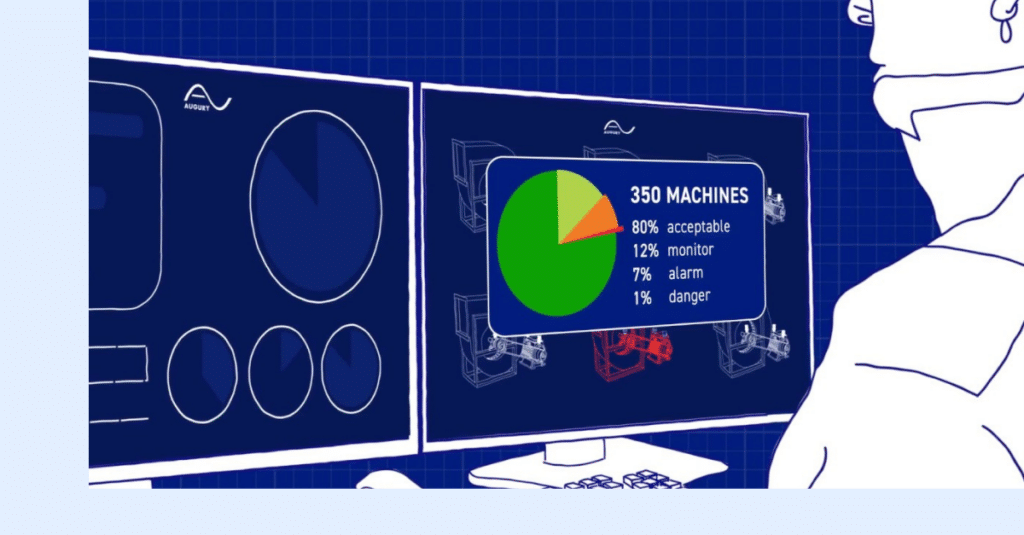
What happens when your machines stay fit, and all downtime is planned? It’s time to scale your ambitions around Machine Health by aligning with Process Health. And as step one, you will need a shared source of data-driven truth for your maintenance and operations teams to unite behind. Welcome to Machine Health 2.0 – when the Lean dream finally comes true.
Always Aiming For A Bigger Picture
Unplanned downtime was always the Achilles heel for manufacturing in terms of both safety and business costs – and remains so for many companies. In fact, it may have only gotten worse for some. Tangled supply chains can now have you waiting 12 to 14 weeks for a spare part – a situation few can afford.
Helping manufacturers avoid downtime was our main pitch for a long time. But now, with our more mature customers experiencing limited downtime, we are in a position to promise more – while still building on that Machine Health foundation.
In other words, the Machine Health you enjoy today, shouldn’t be the Machine Health you enjoy tomorrow. You should always aim to expand your view to get a bigger, data-driven picture of the world around you.
Recently, I wrote ‘How Do You Measure Success Once You Beat Unplanned Downtime?’, which was about measuring value beyond that always essential metric ROI. Now, I’d like to build out on that to explain the next steps once you have a healthy Machine Health program and want to take the next steps toward full Production Health.
Naturally, the ultimate goal would be understanding the full interplay between machines and processes to help you decide how to run your business best.
Understanding The Impact Of Process On Your Assets
On a simple level, there’s always work to be done. Regarding coverage, there are always new machines, components, diagnostic methods, use cases, and environments to contend with. Similarly, in terms of insights and engagement, you can always work to expand your machine diagnostic capabilities, insight accuracy, expertise, and useability. Certainly, we can also work to improve infrastructure in terms of IoT resilience, auto-recovery, serviceability, and scalability.
Meanwhile, you can also start looking at the next order of magnitude problem. For instance, how do the processes affect the machines? For example, if I changed formulas, do I see issues arise around the behavior of the bearings and the pumps? And conversely, are the machines having an impact on the processes?
Naturally, the ultimate goal would be understanding the full interplay between machines and processes to help you decide how to run your business best. This end goal is what we call Production Health – and we fully plan to get there one step at a time.
“Mr. Gorbachev, Tear Down This Wall!”
(AKA Getting Everyone On The Same Page)
The first step is to erase that pesky ampersand between Maintenance & Operations. This ampersand represents a huge wall, which heavily influences how people communicate and run their businesses. And, the goal of Machine Health 2.0 is to ensure that this wall gets torn down and stays down.
We need everyone to stare at the same screen – a screen that unifies all views. We must be able to see how machines and processes influence each other in real-time. And we need to do this together. We need the maintenance and operations teams to collaborate around common insights.
Only with such a system in place can we aim our ambitions even higher towards full Production Health.
Yet, even in the best organizations, the operations and maintenance teams often work at odds with each other. And this is largely because they are looking at different dashboards.
Like TPM, But Different
Of course, removing the ampersand is not a new concept. TPM (Total Productive Maintenance) has always had it right, as do all its permutations, whether TPS, Lean, or Six Sigma. These disciplines embrace the idea of continual improvement and aspire for better decision-making based on a holistic view brought on by breaking down silos. They also recognize that it’s both a technological journey and a people’s journey.
TPM is the team we belong to.
Yet, even in the best organizations, the operations and maintenance teams often work at odds with each other. And this is largely because they are looking at different dashboards. The data – as well as the context – is not aligned. Hence, the drive to efficiency – and the ability to make ultimately effective decisions – hits a wall.
So let’s get everyone on the same page and talking to each other – machines-talking-to-processes, people-talking-with-people.
Making TPM Come True: A Single Source Of Truth
I’d argue the noble goals behind TPM were slowed by technology. As a result, manufacturers could only go so far. The data has been too disjointed and disconnected for them to get the full view.
And that’s what we are now able to change. We can bring the different streams of once isolated – or even non-existent – data and get it on a single screen for a single team to really see how assets and processes interact. After all, a shared context is a shared reality – and one on which you can work together on continual improvement.
So let’s get everyone on the same page and talking to each other – machines-talking-to-processes, people-talking-with-people. In that way, people can tweak the machines and the processes for the best possible outcomes.
Ready for the next era of efficiency?





